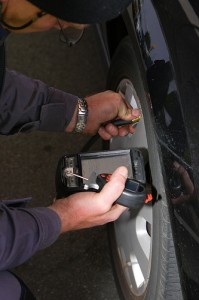 Back in 2010, G. E. Miller wrote an article about nitrogen tire inflation, and questioned whether or not the practice really provided the benefits that nitrogen providers claimed. Yes, the article is almost two years old, but it’s one of the most recent articles out there. However, G. E. Miller makes several factual errors in his arguments against nitrogen tire inflation, and this misinformation could be steering people away from a money-saving practice. We’re going to clear up some of that misinformation, and show you that nitrogen tire inflation does improve gas mileage and save you money.
Back in 2010, G. E. Miller wrote an article about nitrogen tire inflation, and questioned whether or not the practice really provided the benefits that nitrogen providers claimed. Yes, the article is almost two years old, but it’s one of the most recent articles out there. However, G. E. Miller makes several factual errors in his arguments against nitrogen tire inflation, and this misinformation could be steering people away from a money-saving practice. We’re going to clear up some of that misinformation, and show you that nitrogen tire inflation does improve gas mileage and save you money.
About midway through the article, Miller says,“Dry air (the stuff we breathe) actually consists of 78.09% nitrogen, and 20.95% oxygen.” Although Miller’s percentages are correct, notice that they don’t equal 100 percent. That’s because the last one percent includes other elements, including water vapor. Meaning, the air we breathe is not dry air, and neither is the compressed air going into your tires. Miller’s statement isn’t accurate at all. Yes, air is over 78 percent nitrogen, but it’s the other elements of air that can damage tires and not be as reliable to maintain proper tire pressure.
After that, Miller refers to a Consumer Affairs article on nitrogen tire inflation, which says that “the person filling the tires would actually need to completely purge and refill the tire 3 times to get a 95% nitrogen consistency.” That may be the case, but a tire doesn’t have to be purged completely in order for the affects of nitrogen tire inflation to take place. Nitrogen helps maintain proper tire pressure for a longer period of time, and it is less affected by temperature changes than compressed air, even topping off your tires with nitrogen will help them in the long run.
Towards the end of the article, Miller says, “The other argument for nitrogen over air is that oxygen within normal air causes ‘oxidation’ within the tire. However, I haven’t seen any concrete evidence as to what oxidation really is or why its such a bad thing.” Oxidation is the interaction between oxygen molecules and all the different substances they may contact, from metal to living tissue. According to this definition, rust counts as oxidation, and I hardly believe that Miller has never seen rust before, or would argue that a rusty nail is as good as a non-rusty nail. Rust is concrete evidence of what oxidation is (even though it isn’t the only example), but to write off a scientific word just because it’s hard to understand doesn’t mean that it’s harmless or made up.
Miller also says that “If it’s rubber deterioration from the inside, I have a feeling that tire tread wear on the outside from normal use probably has a much larger impact, regardless of what’s inside the tire.” But, tire tread wear and rubber deterioration are not the same thing. Tire tread wear is obvious, but rubber deterioration is the break down of the actual tire. Both not only have an impact on tire performance, but both are also affected by proper tire pressure and nitrogen tire inflation. If you are driving on tires that are over or underinflated, then that will affect how your tire tread wears over time. The strength of the tire rubber is just as important as the tire tread wear itself.
The science behind Miller’s article is wrong and misinformed, misguiding readers into thinking that nitrogen tire inflation can’t be any good, when in fact it can do a lot of good once you understand the science.








